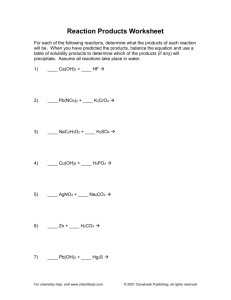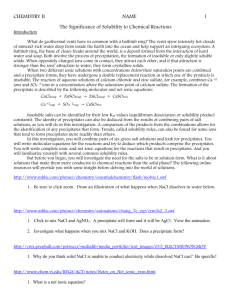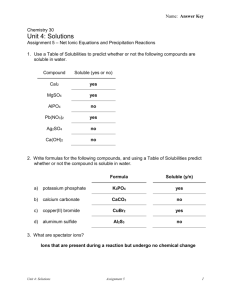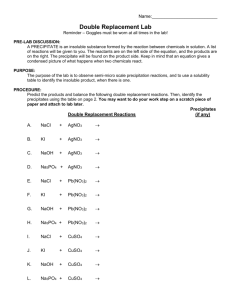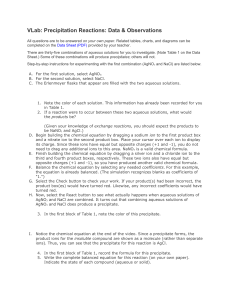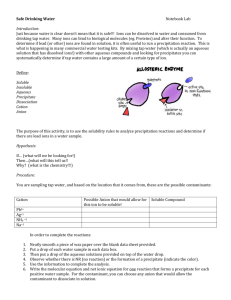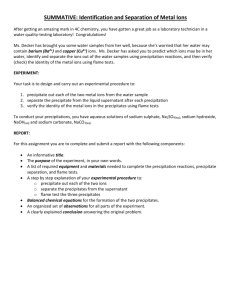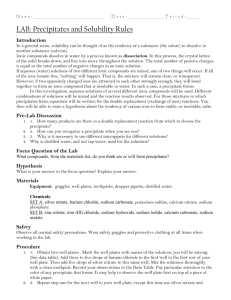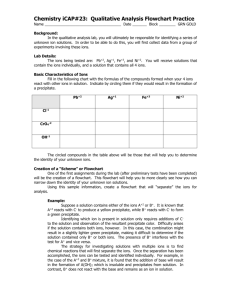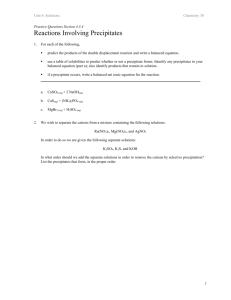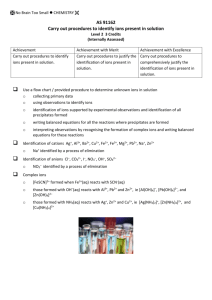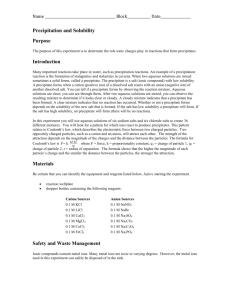Precipitates Lab
advertisement
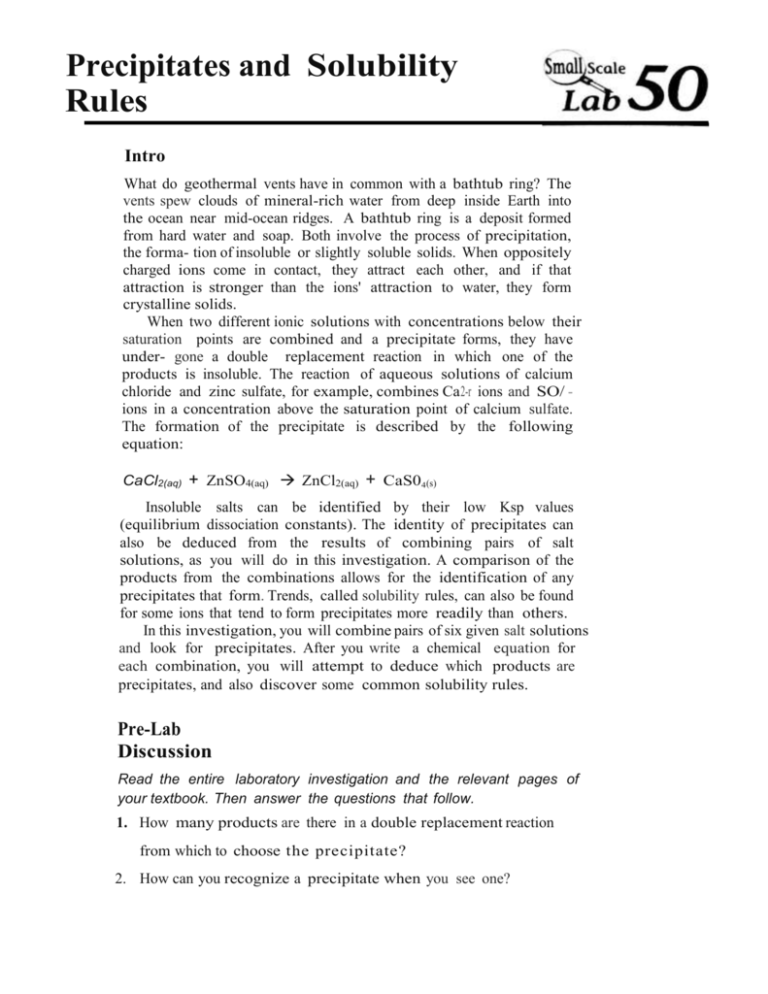
Precipitates and Solubility Rules Intro What do geothermal vents have in common with a bathtub ring? The vents spew clouds of mineral-rich water from deep inside Earth into the ocean near mid-ocean ridges. A bathtub ring is a deposit formed from hard water and soap. Both involve the process of precipitation, the forma- tion of insoluble or slightly soluble solids. When oppositely charged ions come in contact, they attract each other, and if that attraction is stronger than the ions' attraction to water, they form crystalline solids. When two different ionic solutions with concentrations below their saturation points are combined and a precipitate forms, they have under- gone a double replacement reaction in which one of the products is insoluble. The reaction of aqueous solutions of calcium chloride and zinc sulfate, for example, combines Ca2-r ions and SO/ ions in a concentration above the saturation point of calcium sulfate. The formation of the precipitate is described by the following equation: CaCl2(aq) + ZnSO4(aq) ZnCl2(aq) + CaS04(s) Insoluble salts can be identified by their low Ksp values (equilibrium dissociation constants). The identity of precipitates can also be deduced from the results of combining pairs of salt solutions, as you will do in this investigation. A comparison of the products from the combinations allows for the identification of any precipitates that form. Trends, called solubility rules, can also be found for some ions that tend to form precipitates more readily than others. In this investigation, you will combine pairs of six given salt solutions and look for precipitates. After you write a chemical equation for each combination, you will attempt to deduce which products are precipitates, and also discover some common solubility rules. Pre-Lab Discussion Read the entire laboratory investigation and the relevant pages of your textbook. Then answer the questions that follow. 1. How many products are there in a double replacement reaction from which to choose the precipitate? 2. How can you recognize a precipitate when you see one? 3. Why is it necessary to use different droppers for each of the different solutions? 4. Each of the solutions made today were made using distilled water (water that has been put through a filtering system that takes out all of the impurities and ions that would otherwise be in the water). Why is this a necessary step? Problem What are the precipitates that form from the reactions of salt solutions? Safety Wear your goggles and lab apron at all times during this investi gation. Silver nitrate (AgNO3)causes stains to skin and clothing. Procedure Put on your goggles and lab apron. Obtain micropipets of each solution and label them if necessary. Mark the well plates with the names of the six solutions in the manner shown in the Data Table. 4 l.i l In the upper left well of the well plate, combine the first pair of solutions, ten drops each, using the micropipets. Note the appearance or absence of a precipitate and record your observation in the Data Table. Write NR if there is no reaction. I i ·) • l 3. Continue the solution cornbinations (15 total) until each of the solutions has been combined with all of the others. Record the results in the Data Table. 4. Dispose of any solutions containing silver compounds in a labeled container. . 5. Wash_ the well plate with soapy water and rinse thoroughly and finally r i n s e w i t h distilled water. Clean up your work area and wash your hands before leaving the laboratory. Observations DATA TABLE (the ‘X’ indicates duplicate boxes that do not need to be filled in) AgN03 NaNO3 K3PO4 Na2CO3 MgCl2 CuSO4 MgCl2 X Na2CO3 K3PO4 NaNO3 X X X X X X X X X Critical Thinking: Analysis and Conclusions 1. Complete AND balance the double replacement reaction equations for each combination. Leave blank spaces for the phase symbols. You will fill them in for Question 2. (Applying concepts) CuS04(aq) + AgN03(aq) MgCl2(aq) + AgNO3(aq) Na2C03(aq) + AgNO3 (aq) K3P04(aq) + AgNO3 (aq) + AgNO3(aq) CuS04(aq) + NaN03(aq) MgCl2(aq) + NaNO3(aq) Na2CO3(aq) + NaNO3(aq) K3P0 4(aq) + NaNO3(aq) CuSO4(aq) + K3P04(aq) MgCl2(aq) + K3PO4(aq) Na2C03(aq) + K 3P04(aq) CuS04(aq) + Na2CO3(aq) NaNO3(aq) MgCl2(aq) + Na2C03(aq) CuS04(aq) + MgCl2(aq) 2. Find those equations in Question 1 that have no precipitate in the products. The products in these equations are salts that must be soluble. Label each of these salts with (aq), like the reactants that are soluble. Search for these same soluble salts in the products of the reactions that did produce precipitates. Where they occur, label them (aq), and note that the other product must be the precipitate. Label the precipitates with the symbol (s) for "solid." Refer to the solubility rules t a b l e for help. 3. Fill in the conclusions for the following list based on your lab results a. List all metal ions that are not part of any precipitate. b. List all the negative ions that are not part of any precipitate. c. List all metal ions that occur only in products that are precipitates. d. List all metal ions sometimes found in a precipitate.
